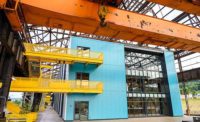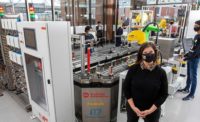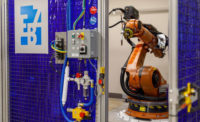Manufacturing in the age of Industry 4.0, digitally connected machines and smart factories require a new breed of engineers who are equipped with a fresh set of skills. That’s why Arizona State University recently launched the School of Manufacturing Systems and Networks.
The goal of the school is to support a local manufacturing ecosystem that includes a robust aerospace and electronics sector. Companies such as Boeing, General Dynamics, Honeywell Aerospace, Northrop Grumman and Raytheon produce helicopters, missiles, satellites and other products in Arizona, while Amkor, Intel, NXP and TSMC focus on microelectronics and semiconductors. The Southwest is also becoming a hotbed for electric vehicle manufacturers, attracting startups such as Atlis, ElectraMeccanica, Lucid and Nikola.
All of those companies are hungry for new talent armed with knowledge about additive manufacturing, artificial intelligence, cybersecurity, data analytics, digital twins, robotics and other cutting-edge topics.
The School of Manufacturing Systems and Networks, part of the Fulton Schools of Engineering, is building upon existing manufacturing and systems engineering programs at ASU and strategically centering its curriculum, research portfolio and industry engagements to meet the growing demands of an evolving manufacturing landscape.
“If you look across the country, there are more than 2 million manufacturing jobs that could go unfilled, and this particular school is trying to fill that workforce gap,” says Binil Starly, Ph.D., a mechanical engineering professor who serves as director of the School of Manufacturing Systems and Networks. “As one of the country’s largest and most comprehensive engineering schools, [we are] well-positioned to lead industry-relevant research and technology innovation in the processes and systems that will drive the future of manufacturing.”
The Fulton Schools of Engineering are not housed on the main ASU campus in Tempe. They are located on the polytechnic campus, which is about 30 minutes away in Mesa. The school offers nine undergraduate and 13 graduate degree programs, focusing on hands-on, project-based learning and industry partnerships. ASU is also well-known for an online program that enables students to earn degrees from anywhere in the world.
The polytechnic campus is already home to the robotics and autonomous systems program, the information technology program, the software engineering program and the human systems engineering program, which focuses on how humans engage with new technologies.
The campus also boasts an innovation hub where students have an opportunity to learn and experiment in a 15,000-square-foot 3D-printing research center. It houses more than $2 million worth of metal and plastic additive manufacturing equipment.
“The School of Manufacturing Systems and Networks will integrate various academic programs and innovative research initiatives to address current and future challenges, improve sustainability and generate economic opportunities to revitalize manufacturing in Arizona and beyond,” explains Starly. “We plan to play a significant role in supplying the skilled talent needed to support domestic efforts to re-establish America’s leadership in advanced manufacturing.
“The goal is to create the next generation of manufacturing engineers who can go out and address some of the challenges of reshoring in the era of Industry 4.0 and digital factories,” adds Starly. “It will be one of the only programs in the country that caters to these particular needs.
“We currently have about 200 students and 15 faculty members,” Starly points out. “But, we hope to eventually grow the program and have up to 30 faculty and an enrollment of more than 1,000 students. We will also be launching an online program by the end of 2024.”
Starly and his colleagues are primarily focusing on three key areas: automation and robotics; cyber manufacturing and the integration of information technology and operations technology; and connected, data-driven manufacturing systems.
“We’re revamping our undergraduate- and graduate-level curriculum and getting feedback from local manufacturers about what they need,” says Starly. “We’ve had in-depth discussions about what types of hard and soft skills they’d like to see students graduate with. For instance, what specific skills are needed for EV manufacturing?
“One of our goals is to increase attention to automation and robotics,” adds Starly.
The lab is currently equipped with Fanuc six-axis robots and UR collaborative robots. The former are primarily used for training applications, while the latter are used in research applications.
“Another area we’re focusing on is space manufacturing,” explains Starly. ‘We’re addressing topics such as how to manufacture in micro-gravity environments. We also plan to provide infrastructure that will allow us to test and validate various methods that can expand exciting new opportunities in space.”
The School of Manufacturing Systems and Networks will eventually be housed in a dedicated building that’s currently in the planning stage. When it opens in fall 2025, it will be one of the largest buildings on the polytechnic campus.
“The building will feature around 180,000-square-feet of space on four levels, with lots of collaborative areas where students can experience the next generation of manufacturing technology in action,” notes Starly. “It will be designed as a learning factory equipped with a variety of mini pilot production lines.
“This part of the building will be highly visible,” says Starly. “The manufacturing labs will not be hidden away in the basement. We’ll have lots of glass walls on the first floor that people can see through and view various machines in operation.”
Starly also believes the new facility will play an important role in senior design capstone projects that are aligned with the needs of local manufacturers. For instance, Honeywell Aerospace typically sponsors eight to 12 capstone projects annually, giving students an opportunity to generate tangible engineering and manufacturing solutions for the company.
One recent capstone project entitled “Modeling the Factory of the Future” involved four students who developed a digital twin of an existing Honeywell T55 helicopter engine assembly line at the company’s Phoenix facility. Their goal was to identify key areas of needed improvement to the line, such as ergonomics and overall cycle time.







